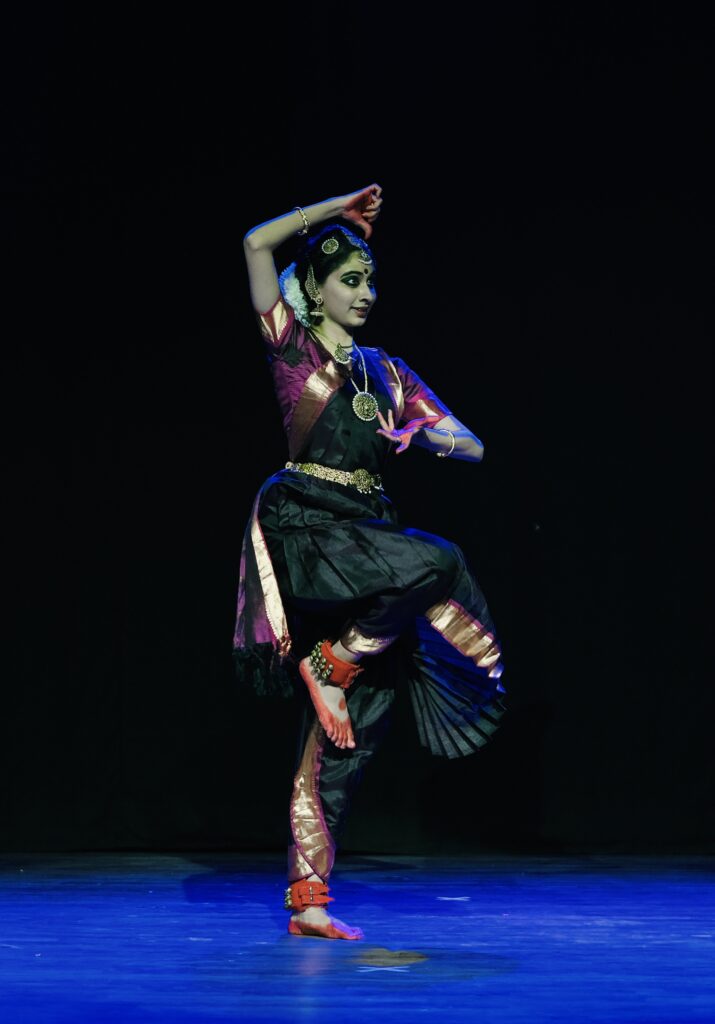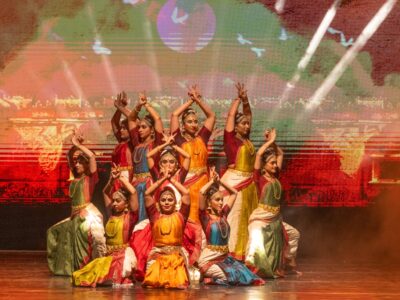Sahitya’s Margam is a rarely attempted feat in current times. It is the first time for young Bharatanatyam dancer Sahitya Ramkumar to present a ticketed program at Rangbhoomi, Gachibowli last Sunday, which was a massive success.
(Text by Anna Rao & Pictures by K. Sreenivas)
Sahitya’s ‘Margam’ showcased a beautiful art exploration, which was entirely choreographed by her and was a hit and full-house show. Her idea was to present an entire “Margam” which is the term applied to a selection of items in a certain order. Margam has a long history going back to the Tanjore Quartet of musicians, who standardised this repertoire. The length of the format involved requires stamina and careful planning and hence is being rarely attempted in recent times.

The program started dramatically with a darkened stage where the artiste was slowly revealed as a silhouette bathed in red lighting picturising the Divine mother Lalitha as seen emerging from the sacred fire, her birth place. The grandeur of Adi Sankaracharya’s great Sanskrit shlokas manifested a sacred aura as the artiste through her dance went on to create a visual portrait of the Goddess from the crown of her head to her bejewelled toes.

The various divine forms of the Mother with their attributes and weapons: Amba Parvati and Durga emerged on stage through the artiste’s portrayal in her movements and expressive poses like a series of three dimensional moving Images of these deities. Both the fierce and the protective natures were evocatively depicted by the usage of swaras.
The varnam is the most extensive piece in the recital and requires considerable experience and demonstrates the maturity of the artiste. Sahitya used this opportunity to superbly and in a seemingly effortless display of a dazzling combination of nritta, natya and abhinaya to successfully render an unusual piece in Tamil of an esoteric nature.
 The divine secret present in the Temple of Shiva as the God of Dance is known as the “Chidambara Rahasyam”. The heroine pines and aspires to realise the infinite. She peeps through the temple veil and witnesses the form of Nataraja. This is the metaphor symbolising the capacity to transcend the physical and achieve enlightenment.
The divine secret present in the Temple of Shiva as the God of Dance is known as the “Chidambara Rahasyam”. The heroine pines and aspires to realise the infinite. She peeps through the temple veil and witnesses the form of Nataraja. This is the metaphor symbolising the capacity to transcend the physical and achieve enlightenment.
For this piece from Sahitya’s Margam repertoire – Inspiration was also drawn from other dance forms like Baul. Shiva is also shown as simultaneously possessing the attributes of man and woman united in a single divine form. He is both light and sound too. In the next item, a soothing lullaby is heard as Sahitya conveyed enchantingly through pure expression a mother putting her baby to sleep. The mother is the Queen of Travancore and the baby is the famous ruler, Swathi Thirunal. He is referred to as a “ Treasure from God “ and “ the Fruit From the Tree of Fortune “.
Interestingly, throughout this song, nowhere is the word sleep used but it is the soporifically lulling ability of the raga, which is called upon to do the needful. The thillana was energetic and contained phrases in praise of lord Muruga. The dancer through her stance and movements evoked a stylised version of his Vahana the peacock. Her head held high with hand movements to resemble the beak and fluttering wings and tail of the bird brought it to life.

A sprightly Marathi Abhang rounded off the performance. The dancer’s energy infused spirit into a devotional poem of Namdev depicting the dark hued God bedecked with yellow attire, who had come to protect his Bhaktas. Motherly angle of a Masculine Deity was extolled. Vitthala was the refrain. The melody made the audience vibrant with appreciation – concluding the entertaining evening.















